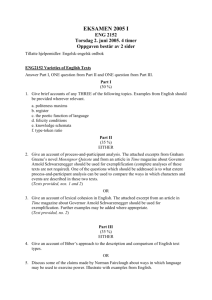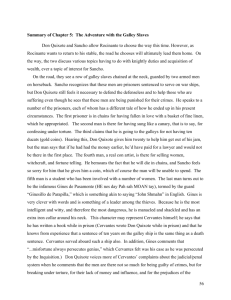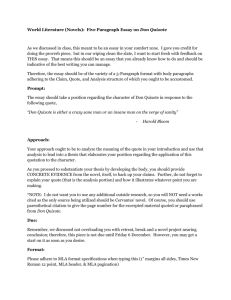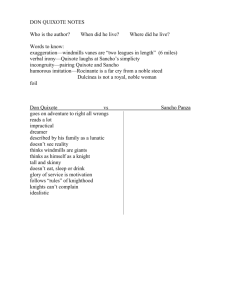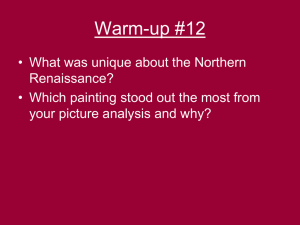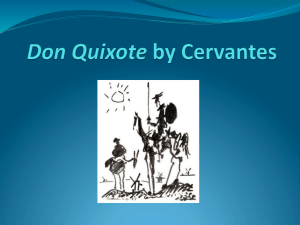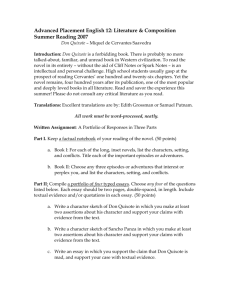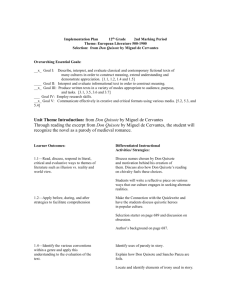DON QUIXOTE (SPARKNOTES)
advertisement
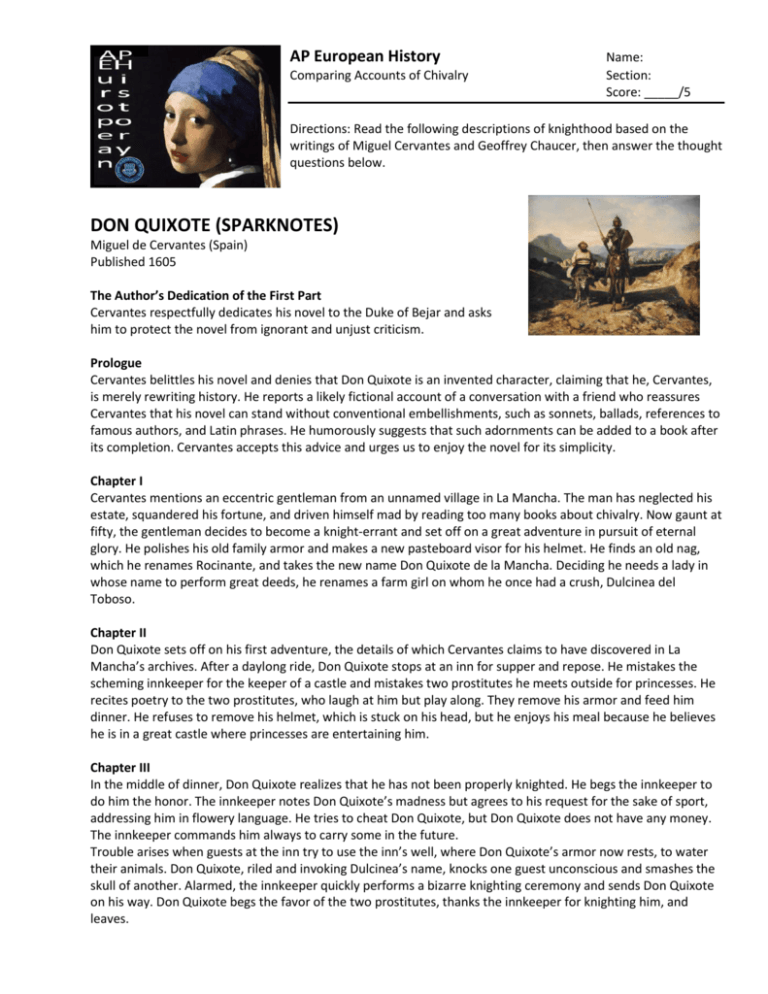
AP European History Comparing Accounts of Chivalry Name: Section: Score: _____/5 Directions: Read the following descriptions of knighthood based on the writings of Miguel Cervantes and Geoffrey Chaucer, then answer the thought questions below. DON QUIXOTE (SPARKNOTES) Miguel de Cervantes (Spain) Published 1605 The Author’s Dedication of the First Part Cervantes respectfully dedicates his novel to the Duke of Bejar and asks him to protect the novel from ignorant and unjust criticism. Prologue Cervantes belittles his novel and denies that Don Quixote is an invented character, claiming that he, Cervantes, is merely rewriting history. He reports a likely fictional account of a conversation with a friend who reassures Cervantes that his novel can stand without conventional embellishments, such as sonnets, ballads, references to famous authors, and Latin phrases. He humorously suggests that such adornments can be added to a book after its completion. Cervantes accepts this advice and urges us to enjoy the novel for its simplicity. Chapter I Cervantes mentions an eccentric gentleman from an unnamed village in La Mancha. The man has neglected his estate, squandered his fortune, and driven himself mad by reading too many books about chivalry. Now gaunt at fifty, the gentleman decides to become a knight-errant and set off on a great adventure in pursuit of eternal glory. He polishes his old family armor and makes a new pasteboard visor for his helmet. He finds an old nag, which he renames Rocinante, and takes the new name Don Quixote de la Mancha. Deciding he needs a lady in whose name to perform great deeds, he renames a farm girl on whom he once had a crush, Dulcinea del Toboso. Chapter II Don Quixote sets off on his first adventure, the details of which Cervantes claims to have discovered in La Mancha’s archives. After a daylong ride, Don Quixote stops at an inn for supper and repose. He mistakes the scheming innkeeper for the keeper of a castle and mistakes two prostitutes he meets outside for princesses. He recites poetry to the two prostitutes, who laugh at him but play along. They remove his armor and feed him dinner. He refuses to remove his helmet, which is stuck on his head, but he enjoys his meal because he believes he is in a great castle where princesses are entertaining him. Chapter III In the middle of dinner, Don Quixote realizes that he has not been properly knighted. He begs the innkeeper to do him the honor. The innkeeper notes Don Quixote’s madness but agrees to his request for the sake of sport, addressing him in flowery language. He tries to cheat Don Quixote, but Don Quixote does not have any money. The innkeeper commands him always to carry some in the future. Trouble arises when guests at the inn try to use the inn’s well, where Don Quixote’s armor now rests, to water their animals. Don Quixote, riled and invoking Dulcinea’s name, knocks one guest unconscious and smashes the skull of another. Alarmed, the innkeeper quickly performs a bizarre knighting ceremony and sends Don Quixote on his way. Don Quixote begs the favor of the two prostitutes, thanks the innkeeper for knighting him, and leaves. Chapter IV On the way home to fetch money and fresh clothing, Don Quixote hears crying and finds a farmer whipping a young boy. The farmer explains that the boy has been failing in his duties; the boy complains that his master has not been paying him. Don Quixote, calling the farmer a knight, tells him to pay the boy. The boy tells Don Quixote that the farmer is not a knight, but Don Quixote ignores him. The farmer swears by his knighthood that he will pay the boy. As Don Quixote rides away, satisfied, the farmer flogs the boy even more severely. Don Quixote then meets a group of merchants and orders them to proclaim the beauty of Dulcinea. The merchants inadvertently insult her, and Don Quixote attacks them. But Rocinante stumbles in mid-charge, and Don Quixote falls pitifully to the ground. One of the merchants’ mule-drivers beats Don Quixote and breaks his lance. The group departs, leaving Don Quixote face down near the road. Description of a Knight From Geoffrey Chaucer’s Canterbury Tales (England) Written between 1387-1400 Chaucer’s description of “the Knight” in his “General Prologue” may be seen as a multi-layered narration. First he gives a very precise and historically relevant account of his campaigns. Based on what Chaucer knows about the knight’s deeds he gives his own evaluation of his character. Chaucer calls him a “reputable man”, “trustworthy” and “courteous”, loyal to his king, and honored for his abilities. From this description we get an image of a respectable person who “cherished the profession of arms” and acted within a set of moral principles suitable for a knight of his time. It also seems that Chaucer’s characterization of the knight abounds with what may be the knight’s own statements about himself. Several phrases stand out on the background of Chaucer’s objective and rather sensible text: “[he] travelled far; no man as far as he, in Christian and in heathen lands as well”, often he took the highest place at table, over the other foreign knights in Prussia”, “no Christian of his rank fought there more often”.1 Thought Questions: 1. Were the descriptions of knighthood more similar or more different? Use information from the descriptions to support your assertion. 2. Which depiction of European knighthood do you think is more accurate? Explain your reasoning 3. What types of factors might explain the differences in depictions of knights? (List and explain 2 differences)
